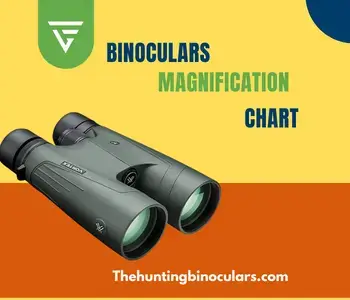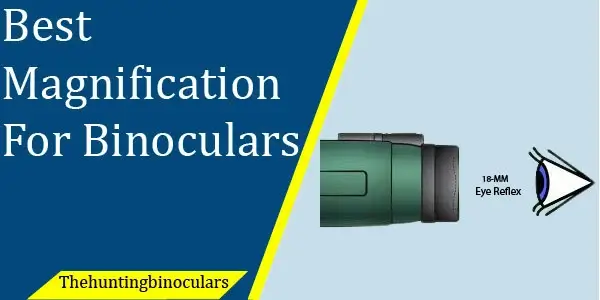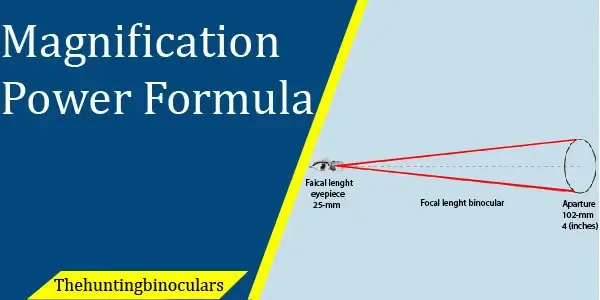
It is defined as the ratio of the objective focal length to the eyepiece focal length. The binocular magnification sometimes represents diameters. When a person sees an object via pair of binoculars, it increases the size of that object, called the binoculars’ magnification power.
When magnification power is more significant, its field of view decreases. A tripod is used for the stabilization of an image. This research article about the binocular magnification chart clears your mind about what you think about binocular magnification.
For the high magnification, some hunters used rangefinder binoculars, rangefinder binoculars measured the distance from the observer to a target.
Table of Contents
Binocular Magnification Chart | A Comprehensive Article
The viewer chooses the binoculars with magnification that suits the situation. Mainly people want binoculars with a diameter of objective lens smaller than 25 and magnifying power of 8 or 10. People use binoculars of small size and are lightweight while traveling.
Different Magnification Power of The Binoculars
There are ten different magnification power of The best binoculars. This is a complete and comprehensive binocular magnification chart guide. You must need high-power magnification for wildlife viewing binoculars.
7x Magnification of The Binoculars
Most people choose binoculars with 7x magnifying power because it is used in many situations. It has a range of 3-5x. It is the best option for the sports fan to see the ground from the seat. It produces an image that is seven times larger than the original one.
10x Magnifications of The Binoculars
It is the best option for people who want to see a far-distant object. Hunters use binoculars with 10x magnification because their range is longer, and it increases the size ten times larger than the original.
8×25 Binoculars Range
The binocular of 8x magnification and 25mm diameter produces an inverted and large image of the object in the microscope. It gathers lighter and glows up the object’s image.
8×42 Binoculars Range
The binocular with an 8×42 specification means that its magnifying power is 8 and 42 is the diameter of an objective lens. It increases the size to eight times larger than normal and produces the sharpest image because it has a greater diameter, so maximum light is collected. It has an exit pupil of greater size
10×25 Binoculars Range
Its magnifying power is 10. When a person sees through it, a clear and large image can be seen. The objective lens diameter is 25 so, it gathers maximum light and forms a sharp image. It produces a better result for magnification, sharper image, and luminous flux.
8×28 Binoculars Range
When seeing through 8×28 binoculars, a person sees eight times the image when seen through the naked eye. It can produce an image with the best resolution.
10×28 Binoculars Range
The magnifying power of the binocular is 10x, and the front lens diameter is 28mm. It is the priority of people to get binoculars with powerful and effective results.
12×42 Binoculars Range
Its magnifying power is 12x, and the diameter of the effective objective lens is 42mm. The distance of the exit pupil is 3.5mm with a 6.5-degree field of view. Its weight is approximately 840 g it can be a choice for every hiker or traveler. Its lightweight along with better resolution is demanding.
20×50 Binoculars Range
When viewers use binoculars with 20×50 specifications, it produces an image of the highest quality. Its magnifying power is 20. A person can see objects 20 times larger than normal. When magnifying power increases, it is difficult to produce a steady image.
10×42 Binoculars Range
10×42 binoculars are commonly used for the best resolution. These binoculars are used when a person sees things in dim light. Its magnification is ten, and the effective diameter of an objective lens is 25mm. The diameter of its exit pupil is 4.2mm, and 7.6 is the field view. It produces a clear and sharp image.
Applications

What Show Numbers in Binoculars (For Example 8×40 )
First Number Show: Magnification Number
In the description of binoculars magnification is the first number. For example, 8×40, 8 is the magnification number. When seeing the object from a distant place, it magnifies the object eight times greater than the original one.
Second Number Show: Object Lens Diameter
And the second number, (For example, 40) in the binocular explanation represents the objective lens diameter. The objective lens is used for two purposes:
It is used to find out the sharpness or resolution of the image. Furthermore, it tells about the light amount that can be collected for image formation.
What Will Happen When Binoculars of The Same Magnification Power Are Used?
When a person sees the same object with two binoculars of sane quality, the same binocular magnification power, and competently same exit pupil, the binocular, which has a high diameter, produces a sharp and bright image.
For example, 8×24 and 8×42 produce an image equally eight times greater than normal when seen with the naked eye. 24mm and 42mm are the front objective lens diameters; when the diameter increases, it gathers maximum light and produces a sharp, clear, and focused image.
Factors
The magnification power of binoculars relies upon the intended application. It is the non-adjustable and permanent character of many binoculars. It is not a feature of zoom binoculars.
Optical Parameters In Binocular Magnification Chart
Before the start of the detail of the binocular magnification chart, there are some optical parameters. These optical parameters are the factors that define the binocular device and determine its performance and limits. Below is a short overview of optical parameters:
Eyepiece
Two or more groups in the binocular eyepieces contain three or more lenses.
Field Lens
The field lens is the lens that is far away from the person’s eye.
Eye Lens
The eye lens is the lens that is closest to the person’s eye.
Kellner Eyepiece
In 1849, Carl Kellner discovered the most familiar configuration of an eyepiece. In this type of singlet and double-concave field, a lens is used. The eye lens arrangement in this eyepiece is a double convex or Plano concave doublet.
In 1975, its reverse version was invented. In this type, the eye lens is double convex, and the singlet and field lens is double concave or convex, which is a doublet. The use of the reverse type gives more than 50% eye relief.
Exit Pupil
The exit pupil is defined as the diameter of the objective divided by the magnification. The light collected into a beam with the help of objective diameter binoculars concentrates it.
The use of an exit pupil that is equal to or the same as the pupil diameter of the human eye produces a brighter image, increases effective light collection and increases the sharpness of the image.
The diameter of the pupil of the human eye is 3mm in the daytime and 7mm in the nighttime. As age increases, this diameter decreases. A person easily puts the eye at the place where maximum light is received; it is convenient with the help of a large exit pupil.
Exit pupil is not universally standard in the daytime. People use big binoculars with greater exit pupils for easy use, adjustability in applications, and comfort. These are good options for the viewers.
Field of View
When using a pair of binoculars, its field of view depends on two factors. One is magnifying power as the field of view is inversely proportional to the magnification commonly, and the second is optical design.
It tells about how many linear and angular values a person can see. A person sees the angular value in degrees and linear value in meters or feet, and its width in meters or yards.
Eye Relief
The distance between the lens of the rear eyepiece and the eyepoint or exit pupil is called eye relief. A viewer places the eye behind the eyepiece in eye relief to see the image. Potential eye relief is increased when an eyepiece of a larger focal length is used.
Eye relief is very important for the wearers of glasses. Its normal range is from a few mm to 2.5 or more cm. When binoculars with slight relief are used, it is hard to handle because of the face problem of keeping them straight.

Close Focus Distance
A binocular can entirely focus on the closest or nearest point, which is called close focus distance. Its value ranges from 0.5 meters to 30 meters. The value of close focus distance depends on the arrangement of the binoculars.
When the close focus distance is smaller than the magnification, viewers use binoculars to see the object because it cannot be seen with the naked eye.
SOME QUESTIONS ARISE IN YOUR MINDS ABOUT MAGNIFICATION
Conclusion
Binoculars are commonly defined by a group of numbers like 7×42, 8×28, and 10×42, etc. 7x, 8x, and 10x represent the magnifying power of the binoculars means the object is 7, 8, and 10 times closer to a viewer when seen with the naked eye. And 42mm, 28mm, and 42mm are the diameter of the objective lens.
As diameter increases, it gathers maximum light to concentrate and form an outstanding resolution. By reading the article “Binocular Magnification Chart” you easily understand magnification.
A sharp and clear image is produced when you can use binoculars of the larger objective lens is used. The object lens has a smaller focal length and produces an inverted and erect object image in the device.

What will I be able to see with Orion 25×100 binoculars…on the moon star gazing or sun. I bought one that has sun filters to look at eclipses.
If a lens is 10 X 30X 60 What does that actally mean.
What does each of these numbers represent.
10 X 30X 60
In the description of binoculars magnification is the first number. For example, 8×40, 8 is the magnification number. When seeing the object from a distant place, it magnifies the object eight times greater than the original one.